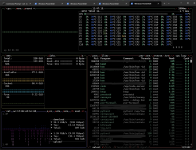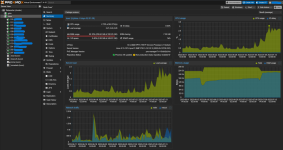Hi there,
I've been running TrueNAS virtualised on old hardware for a year now and have finally decided to build something new/decent. Use case: I don't want to use it just as a NAS, but also to host some VMs/containers. Mostly the usual stuff like Home Assistant, a Docker instance, OPNsense in the future, a Windows VM and maybe Jellyfin.
I've picked out some hardware that I'd like you to have a look at before I actually order it:
Some additional questions:
As staited above I'm already using TureNAS with the 2 WD drives. Right now they are just mirrored. Since I'll prorbalby have to add storage in the future I'd like to know how I should set it up. I'd like to be able to add few drives at a time, being forced to add 4 drives at once it not an option for me. With this limitation I think running multiple, mirrored 2 drive vdevs is the only option, right?
If so, will I be able to change from 3 mirrored vdevs with 2 drives each to a raidz2 vdev with a total of 6 drives in the future without having to export the data to an external drive?
Notes:
Do you have any suggestions for improvement or would you change anything?
I've been running TrueNAS virtualised on old hardware for a year now and have finally decided to build something new/decent. Use case: I don't want to use it just as a NAS, but also to host some VMs/containers. Mostly the usual stuff like Home Assistant, a Docker instance, OPNsense in the future, a Windows VM and maybe Jellyfin.
I've picked out some hardware that I'd like you to have a look at before I actually order it:
- Ryzen 5 Pro 4650G
- 6C/12T, ECC, iGPU for 110€
- Kingston Server DIMM DDR4-3200 CL22 - 2x 32Gb
- cheap ECC memory
- Asus Prime B550 Plus
- cheap motherboard with ecc support and enough PCIe lanes for HBA, 2.5G Ethernet, and possibly a GPU
- be quiet PurePower 11 400W
- good efficiency between 0-15W for 50€
- LSI SAS 9302-8i
- cheap and recommended in this forum
- WD Red 4tb - x2 (already in use)
- x2 SATA SSD as mirrored boot
Some additional questions:
As staited above I'm already using TureNAS with the 2 WD drives. Right now they are just mirrored. Since I'll prorbalby have to add storage in the future I'd like to know how I should set it up. I'd like to be able to add few drives at a time, being forced to add 4 drives at once it not an option for me. With this limitation I think running multiple, mirrored 2 drive vdevs is the only option, right?
If so, will I be able to change from 3 mirrored vdevs with 2 drives each to a raidz2 vdev with a total of 6 drives in the future without having to export the data to an external drive?
Notes:
- I know that a server board is usually recommended, but they are quite large and I've read that the idle power consumption is relatively high, so I chose a consumer MB.
- Sometimes people claim that the Ryzen 4000 APUs are inefficient at idle, however I've found a few guides where people get the system under 10W idle with additional people able to replicate it.
Do you have any suggestions for improvement or would you change anything?




